Rationale of the Week | JR worried about cancer; sorting fact from fiction

For our June 8th Question of the Week, only 64% of respondents chose the best answer. We want to “take a closer look” at this question and determine strategies to choose the best response.
Before we start though, if you don’t want any spoilers and haven’t tried the question yet, you can answer below: Answer Question
Question: JR is taking Metformin 1000mg BID but is worried about getting cancer and is thinking about stopping the metformin.
Which of the following is an accurate statement regarding diabetes and cancer?
Answer Choices:
- People with diabetes have a slightly lower risk of liver and uterine cancers.
- Some brands of metformin were recalled because of an NDMA impurity, so it is best to hold metformin for now.
- There is research suggesting that metformin may be associated with a decreased risk of certain cancers.
- Metformin does not increase the risk of cancer, but it can negatively impact renal function.
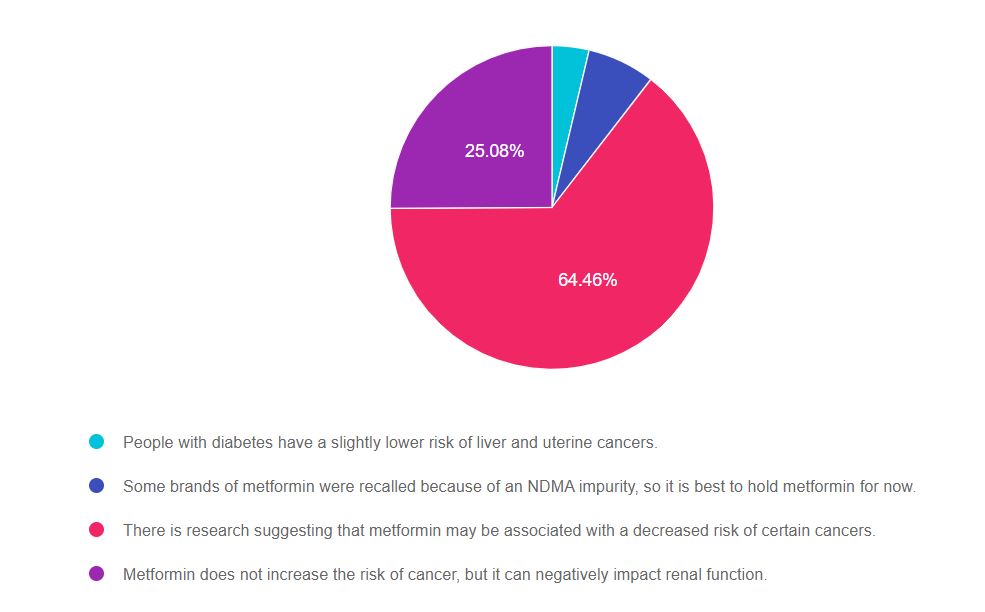
As shown above, the most common choice was option 3, the second most common answer was option 4, then option 2, and finally option 1.
Getting to the Best Answer
If you are thinking about taking the certification exam, the content of this practice test question will set you up for success. The exam will present questions that require test takers to be familiar with knowledge of diabetes co-conditions plus prevention and screening guidelines.
Answers & Rationale
Answer 1 is incorrect, 3.69% chose this answer, “People with diabetes have a slightly lower risk of liver and uterine cancers.” People with type 2 diabetes have a higher risk of getting liver and endometrial cancers. There is an increased risk of diabetes and cancer in the same person due to an overlap of risk factors (age and weight) plus lifestyle factors (smoking, activity level, income and environmental factors).
Answer 2 is incorrect, 6.77% of you chose this answer, “Some brands of metformin were recalled because of an NDMA impurity, so it is best to hold metformin for now.” In 2020, some brands of Metformin were recalled because of above acceptable levels of NDMA due to the manufacturing process. The FDA recalled those brands and they were pulled from pharmacy shelves. Any dispensed metformin post recall should be safe.
Answer 3 is Correct, 64.46% of you chose this answer, “There is research suggesting that metformin may be associated with a decreased risk of certain cancers.” YES, you chose the BEST answer. Congratulations. Multiple studies have examined metformin for its potential tumor and cancer fighting ability and it looks very promising. Read more here >>
Answer 4 is incorrect, 25.08% of you chose this answer, “Metformin does not increase the risk of cancer, but it can negatively impact renal function.” This answer is NOT correct. Metformin appears to reduce the risk of some cancers but does NOT harm kidney function. There has been a increase of misinformation about metformin over the past year. Metformin is not recommended for anyone with a GFR less than 30 due to increase risk of lactic acidosis. But, metformin WON’T harm the kidneys and one could even argue that it protects them by lowering A1C by 1-2% points. You can download our Medication PocketCards for more information.
We hope you appreciate this week’s rationale! Thank you so much for taking the time to answer our Question of the Week and participate in this fun learning activity!
Level 4 | Cancer & Diabetes | 1.25 CEs

Patients with cancer often experience hyperglycemia secondary to treatment, which can increase risk of infection and compromise their nutritional status. In addition, recent research has identified the link between diabetes and cancer. Join us to learn more about this unexpected link and treatment strategies for steroid induced hyperglycemia using a case study approach.
Topics Include:
- Discuss the relationship between cancer, hyperglycemia and insulin resistance.
- State 3 benefits of normalizing glucose levels during chemotherapy.
- Using a case study approach, discuss strategies to improve glucose levels and quality of life.
2021 Live Webinar Events
See Full Calendar for upcoming webinars and Virtual Courses.
Can’t make it live? All paid registrants are guaranteed access to the video presentation, handouts and podcasts.
Sign up for Diabetes Blog Bytes – we post one daily Blog Byte from Monday to Friday. And of course, Tuesday is our Question of the Week. It’s Informative and FREE! Sign up below!
[yikes-mailchimp form=”1″]Accreditation: Diabetes Education Services is an approved provider by the California Board of Registered Nursing, Provider 12640, and Commission on Dietetic Registration (CDR), Provider DI002. Since these programs are approved by the CDR it satisfies the CE requirements for the CDCES regardless of your profession.
The use of DES products does not guarantee the successful passage of the CDCES exam. CBDCE does not endorse any preparatory or review materials for the CDCES exam, except for those published by CBDCE.
Rationale of the Week – Less than 50% chose best answer | New Type 2, Action Needed?

For our June 1st Question of the Week, only 45% of respondents chose the best answer. We want to “take a closer look” at this question and figure out how to drill down to discover the best response.
Before we start though, if you don’t want any spoilers and haven’t tried the question yet, you can answer below: Answer Question
Question: JR is 43 years old with newly discovered type 2 diabetes.
According to the ADA Standards, which of the following actions need to be taken with a new type 2 diabetes diagnosis?
Answer Choices:
- Hepatitis B Vaccine.
- Screening for prostate cancer.
- Referral to podiatry.
- Antibody testing to confirm the diagnosis.
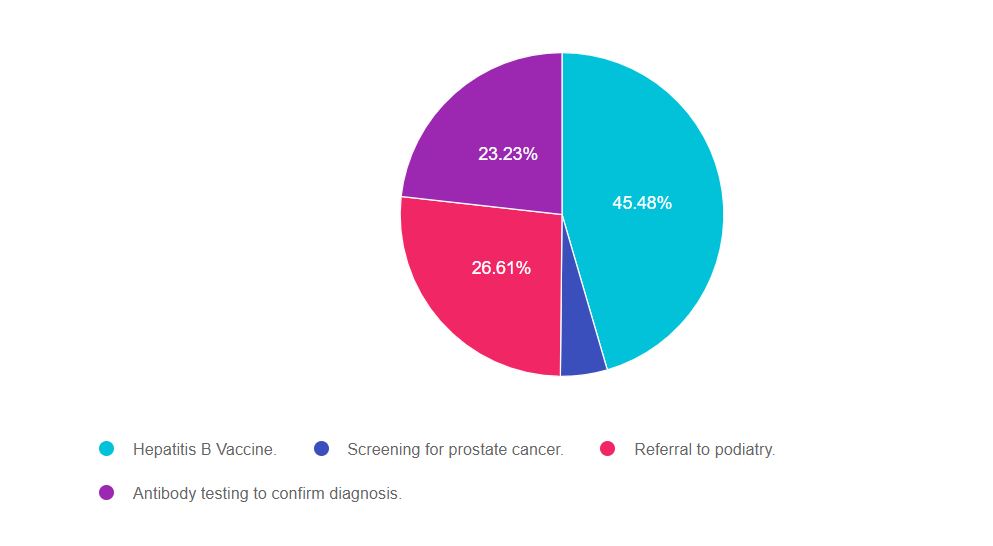
As shown above, the most common choice was option 1, the second most common answer was option 3, then option 4, and finally option 2.
Getting to the Best Answer
If you are thinking about taking the certification exam, the content of this practice test question will set you up for success. The exam will present questions that require test takers to be familiar with preventive care measures, especially suggested vaccinations based on age and risk profile.
Answers & Rationale
Answer 1 is correct, 45.48% chose this answer, “Hepatitis B Vaccine.” CONGRATS, this is the BEST answer. According to the ADA Standards of Care (see below), people with diabetes who are 18-59 years of age need protection against hepatitis infection. Since people with diabetes may share glucose checking devices and may have less hearty immune systems, they are at higher risk of getting Hepatitis B. Getting the 2-3 dose series if not previously vaccinated, offers important protection.
Answer 2 is incorrect, 4.68% of you chose this answer, “Screening for prostate cancer.” According to the ADA Standards, a new diagnosis of type 2 diabetes does not require screening for prostate cancer. In addition, according to the consensus statement on Diabetes and Cancer, men with diabetes are not at higher risk of prostate cancer. However, people with diabetes are at higher risk of pancreas, liver and breast cancer, so regular screenings for these types of cancers is indicated.
Answer 3 is incorrect, 26.61% of you chose this answer, “Referral to podiatry.” This is answer is juicy, but we don’t have enough details in the question to support referral to a podiatrist. Not everyone with new diabetes is referred to podiatry for lower extremity care. Podiatry referral is based on a careful lower extremity assessment coupled with an indication that this person is at higher risk of complications (ie ulcerations, severe calluses, risk of injury when cutting toenails, loss of protective sensation, etc).
Answer 4 is incorrect, 23.23% of you chose this answer, “Antibody testing to confirm the diagnosis.” Another juicy answer. For most people with new type 2 diabetes, the clinical presentation coupled with family history and ketone status is usually enough to determine the type of diabetes. If the question hinted that this person might have type 1 (ie history of celiac or thyroid disease, positive ketones, BMI of 21 etc) then, the provider may want to evaluate for the presence of antibodies.
We hope you appreciate this week’s rationale! Thank you so much for taking the time to answer our Question of the Week and participate in this fun learning activity!
Sign up for Diabetes Blog Bytes – we post one daily Blog Byte from Monday to Friday. And of course, Tuesday is our Question of the Week. It’s Informative and FREE! Sign up below!
[yikes-mailchimp form=”1″]Accreditation: Diabetes Education Services is an approved provider by the California Board of Registered Nursing, Provider 12640, and Commission on Dietetic Registration (CDR), Provider DI002. Since these programs are approved by the CDR it satisfies the CE requirements for the CDCES regardless of your profession.*
The use of DES products does not guarantee the successful passage of the CDCES exam. CBDCE does not endorse any preparatory or review materials for the CDCES exam, except for those published by CBDCE.
Rationale of the Week | What are Pediatric Glucose Targets?

For our June 15th Question of the Week, only 54% of respondents chose the best answer. We want to “take a closer look” at this question with the aim for 100% correct responses the next to go around.
Before we start though, if you don’t want any spoilers and haven’t tried the question yet, you can answer below: Answer Question
Question: RT is 12 years old and has a new diagnosis of type 1 diabetes.
Based on the ADA Standards of Care, what is the most accurate statement regarding glycemic goals?
Answer Choices:
- Glucose targets are based on the individual.
- Strive to achieve at least 80% time in range.
- A1C less than 6.5% for children under the age of 18.
- Pre-meal glucose of 80-130 and post-meal glucose less than 200 to prevent hypoglycemia.
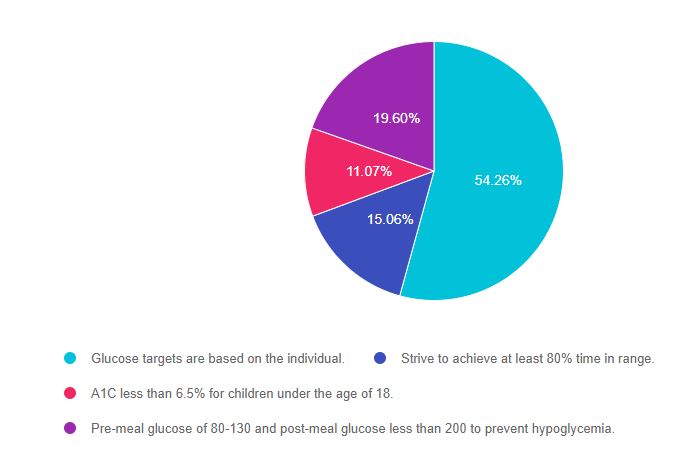
As shown above, the most common choice was option 1, the second most common answer was option 4, then option 2, and finally option 3.
Getting to the Best Answer
If you are thinking about taking the certification exam, the content of this practice test question will set you up for success. The exam will present questions that require test takers to be familiar with the goals of care for specialty populations, including pediatrics.
Answers & Rationale
Answer 1 is Correct, 54.26% chose this answer, “Glucose targets are based on the individual.” GREAT JOB. This is the best answer. The American Diabetes Association provides a general A1c target of 7% or less for pediatrics, but it encourages the person with diabetes and the care provider to determine glucose ranges that best match the individual based on their values, preferences, access to technology and safety.
Answer 2 is incorrect, 15.06% of you chose this answer, “Strive to achieve at least 80% time in range.” According the the ADA, the time in range target is 60% or an A1c of less than 7.5% for those under the age of 25. Of course, these goals are customized to match the individual.
Answer 3 is incorrect, 11.07% of you chose this answer, “A1C less than 6.5% for children under the age of 18..” This is a juicy answer. This target may be right for those who are using a CGM, pump and advanced technology features that help users avoid hypoglycemic events. But this is not the A1C target for all children with type 1 diabetes, so this is not the best answer. There is no A1C target that fits all.
Answer 4 is incorrect, 19.60% of you chose this answer, “Pre-meal glucose of 80-130 and post-meal glucose less than 200 to prevent hypoglycemia.” The American Diabetes Association provides a general A1c target of 7% or less for pediatrics, but it encourages the person with diabetes and the care provider to determine pre and post meal glucose ranges that best match the individual based on their values, preferences, access to technology and safety.
We hope you appreciate this week’s rationale! Thank you so much for taking the time to answer our Question of the Week and participate in this fun learning activity!
Want to learn more about this topic? Enroll in our
Level 2 | From Tots to Teens Diabetes Standards | 1.5 CEs

This course includes updated goals and guidelines for children living with type 1 or type 2 diabetes. This course discusses the special issues diabetes educators need to be aware of when working with children with diabetes and their families.
We discuss the clinical presentation of diabetes, goals of care, and normal growth and development through the early years through adolescence. Strategies to prevent acute and long term complications are included with an emphasis on positive coping for family and child with diabetes.
Topics include:
- Discuss the goals of care for Type 1 and Type 2 Kids with Diabetes
- State Strategies to prevent acute and chronic complications
- Discuss the importance of positive psychosocial adjustment and resources
See Full Calendar for upcoming webinars and Virtual Courses.
Can’t make it live? All paid registrants are guaranteed access to the video presentation, handouts and podcasts.
Sign up for Diabetes Blog Bytes – we post one daily Blog Byte from Monday to Friday. And of course, Tuesday is our Question of the Week. It’s Informative and FREE! Sign up below!
[yikes-mailchimp form=”1″]Accreditation: Diabetes Education Services is an approved provider by the California Board of Registered Nursing, Provider 12640, and Commission on Dietetic Registration (CDR), Provider DI002. Since these programs are approved by the CDR it satisfies the CE requirements for the CDCES regardless of your profession.*
The use of DES products does not guarantee the successful passage of the CDCES exam. CBDCE does not endorse any preparatory or review materials for the CDCES exam, except for those published by CBDCE.
Rationale of the Week | U-500 Insulin Still Causing Confusion

For our May 25th Question of the Week, 71% of respondents chose the best answer, which is awesome! However, for safety and teaching purposes, we still want to “take a closer look” at this question at aim for 100% correct responses the next go around.
Before we start though, if you don’t want any spoilers and haven’t tried the question yet, you can answer below: Answer Question
Question: Mr. J is started on 100 units U-500 twice a day.
Which of the following administration techniques would ensure he gets the right dose?
Answer Choices:
- Using a U-100 syringe, withdraw 100 units.
- Using a U-500 syringe, withdraw 20 units.
- Using a U-500 pen, dial to 100 units.
- Using a U-500 pen, covert to 20 units.
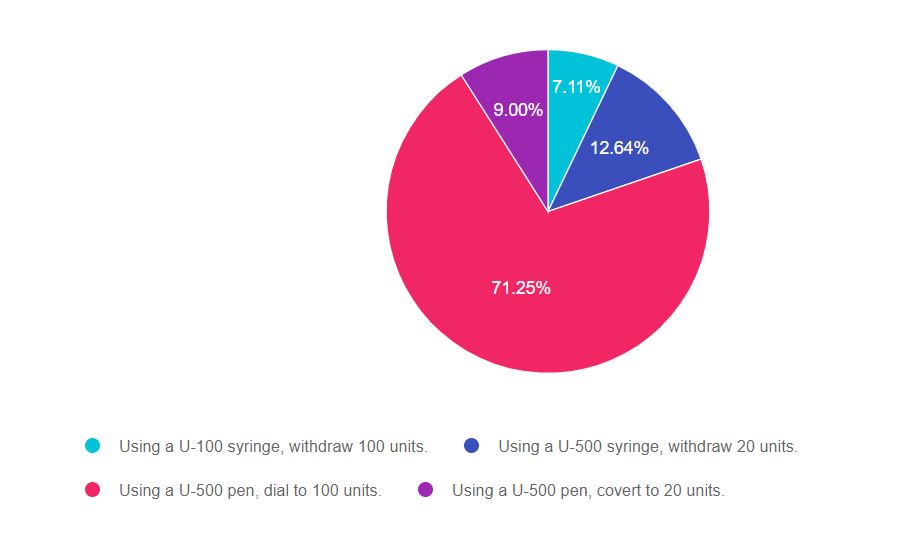
As shown above, the most common choice was option 3, the second most common answer was option 2, then option 4, and finally option 1.
Getting to the Best Answer
If you are thinking about taking the certification exam, the content of this practice test question will set you up for success. The exam will present questions that require test takers to be familiar with accurate dispensing of diabetes medications, injectables and insulins, including the concentrated versions.
Answers & Rationale
Answer 1 is incorrect, 7.11% chose this answer, “Using a U-100 syringe, withdraw 100 units.” This answer is wrong because when withdrawing U-500 insulin from a vial, a U-500 insulin syringe must be used (see image). Since U-500 insulin is 5x’s the concentration of U-100 insulin, drawing up 100 units of U-500 insulin in a U-100 syringe would deliver 500 units of insulin (or 5x’s too much and could be life threatening). See Concentrated insulin card below.
When using a U-500 syringe, no conversion is needed since the syringe automatically delivers the correct dose of U-500 insulin. No conversion, calculations or adjustments required.
Answer 2 is incorrect, 12.64% of you chose this answer, “Using a U-500 syringe, withdraw 20 units.” When using a U-500 syringe, no conversion is needed since the syringe automatically delivers the correct dose of U-500 insulin. No conversion, calculations or adjustments required. For example, if the order reads “100 units of U-500 concentrated insulin twice a day”, using a U-500 syringe, the person would withdraw 100 units of U-500 insulin.
Answer 3 is correct, 71.25% of you chose this answer, “Using a U-500 pen, dial to 100 units.” YES, GREAT JOB! If the order reads “100 units of U-500 concentrated insulin twice a day”, using a U-500 pen, the person would dial to 100 units of U-500 insulin. The pens automatically deliver the correct dose in less volume. No conversion, calculations or adjustments required.
Answer 4 is incorrect, 9.00% of you chose this answer, “Using a U-500 pen, covert to 20 units.” When using a U-500 pen, no conversion is needed since the U-500 pen is specifically created to deliver the correct dose of U-500 insulin. For example, if the order reads “100 units of U-500 concentrated insulin twice a day”, using a U-500 pen, the person would dial to 100 units of U-500 insulin.
We hope you appreciate this week’s rationale! Thank you so much for taking the time to answer our Question of the Week and participate in this fun learning activity!
Want to learn more? Enroll in our
Brand New Online Advanced Courses | Level 4!
We are so excited to expand our Level 4 – Advanced Level & Specialty Topics Series!

Our Level 4 specialty courses are designed to address topics that not only enhance the clinical practice but also prepare participants to take the Board Certification in Advanced Diabetes Management (BC-ADM) exam. The fast-paced content is designed to fulfill curiosity, build on previous significant diabetes care experience and support your journey toward expanding your diabetes knowledge.
Sign up for Diabetes Blog Bytes – we post one daily Blog Byte from Monday to Friday. And of course, Tuesday is our Question of the Week. It’s Informative and FREE! Sign up below!
[yikes-mailchimp form=”1″]Accreditation: Diabetes Education Services is an approved provider by the California Board of Registered Nursing, Provider 12640, and Commission on Dietetic Registration (CDR), Provider DI002. Since these programs are approved by the CDR it satisfies the CE requirements for the CDCES regardless of your profession.*
The use of DES products does not guarantee the successful passage of the CDCES exam. CBDCE does not endorse any preparatory or review materials for the CDCES exam, except for those published by CBDCE.
Rationale of the Week | Best next step?

For our May 18th Question of the Week, 76% of respondents chose the best answer, which is awesome! We still want to “take a closer look” at this question.
Before we start though, if you don’t want any spoilers and haven’t tried the question yet, you can answer below: Answer Question
Question: CT was diagnosed with type 2 diabetes three years ago. The current medication regimen includes 1000 mg of metformin twice daily and 70 units of glargine at night. CT wears an intermittent sensor, and you look at the glucose trends together on CT’s phone app. You both agree that there are consistent postmeal spikes up to 250 almost every day after lunch and dinner. The lowest blood sugar readings are in the 100s. BMI is 33.8 and CT says, “I never feel full”. The most recent A1C is 8.2%, urinary albumin creatinine ratio less than 30.
Based on this information, what intervention would be most likely help CT get to recommended ADA targets?
Answer Choices:
- Add on low-dose sulfonylurea to prevent hypoglycemia.
- Suggest adding a GLP-1 Receptor Agonist.
- Hold metformin, and switch to basal-bolus therapy.
- Encourage CT to get more active, especially after meals.
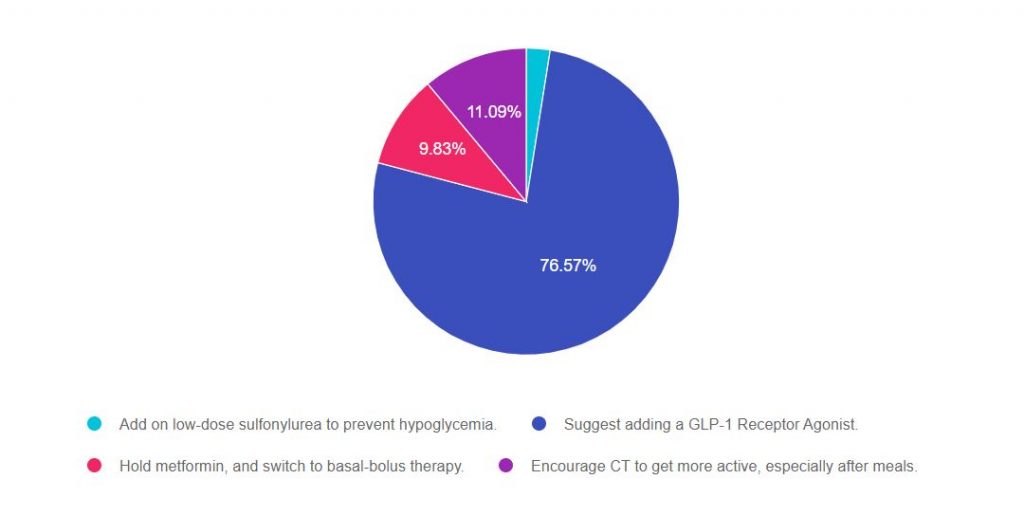
As shown above, the most common choice was option 2, the second most common answer was option 4, then option 3, and finally option 1.
Getting to the Best Answer
If you are thinking about taking the certification exam, the content of this practice test question will set you up for success. The exam will present questions that require test takers to be familiar with the stepwise approach to type 2 diabetes management in a variety of settings and situations.
For a complete listing of diabetes medications, please Download our Medication PocketCards.
Answers & Rationale
Answer 1 is incorrect, 2.51% chose this answer, “Add on low-dose sulfonylurea to prevent hypoglycemia.” Although we might consider this option, we can quickly identify a “tacked on” second half of the answer that makes it a wrong choice. One of the major side effects of sulfonylureas is hypoglycemia, so adding this class of medication wouldn’t prevent hypoglycemia, it would actually increase the risk of low blood sugars.
Answer 2 is correct, 76.57% of you chose this answer, “Suggest adding a GLP-1 Receptor Agonist.” GREAT JOB! Given the fact that CT is on 70 units of basal plus metformin and is experiencing postmeal spikes up to 250 almost every day after lunch and dinner and “never feels full”, adding a GLP-1 is the best choice. Adding a GLP-1 will decrease post meal hyperglycemia and postprandial glucose. In addition, GLP-1s can decrease appetite and increase feelings of satiation. Before suggesting addition of this medication class, it is important to consider insurance coverage and out of pocket cost, since cost could be a barrier.
Answer 3 is incorrect, 9.83% of you chose this answer, “Hold metformin, and switch to basal-bolus therapy.” According to the ADA, when initiating basal bolus insulin therapy for people with type 2 diabetes, they recommend continuing metformin to decrease insulin resistance. The ADA also suggests considering adding a GLP-1 RA or SGLT-2 Inhibitor before switching to basal bolus therapy.
Answer 4 is incorrect, 11.09% of you chose this answer, “Encourage CT to get more active, especially after meals.” While activity is important, this goal is very vague and not really actionable. In addition, “getting active after meals” will certainly improve health and is a great recommendation, but is not likely to drop the A1c to less than the goal of 7% or help with appetite.
We hope you appreciate this week’s rationale! Thank you so much for taking the time to answer our Question of the Week and participate in this fun learning activity!
Want to learn more about this topic? Join us for our upcoming
Level 4 | Solving Glucose Mysteries for Type 2 | 1.5 CEs | Ready to Watch!

Why are glucose levels elevated in the morning? When should insulin be started? What is the next step to get A1c to target?
During this course Coach Beverly addresses each of these glucose mysteries and more, using a person-centered approach. She describes a stepwise approach to evaluate glucose patterns and correct common issues encountered by people living with type 2 diabetes.
By attending this webinar, you will gain confidence in evaluating glucose patterns and making recommendations for improvement.
Objectives
- Describe common glucose mysteries encountered by people with type 2 diabetes.
- Using a stepwise approach, evaluate factors affecting glucose patterns.
- State interventions to increase time-in-range and improve quality of life.
Join us for our Live Webinars
Sign up for Diabetes Blog Bytes – we post one daily Blog Byte from Monday to Friday. And of course, Tuesday is our Question of the Week. It’s Informative and FREE! Sign up below!
[yikes-mailchimp form=”1″]Accreditation: Diabetes Education Services is an approved provider by the California Board of Registered Nursing, Provider 12640, and Commission on Dietetic Registration (CDR), Provider DI002. Since these programs are approved by the CDR it satisfies the CE requirements for the CDCES regardless of your profession.*
The use of DES products does not guarantee the successful passage of the CDCES exam. CBDCE does not endorse any preparatory or review materials for the CDCES exam, except for those published by CBDCE.
Rationale of the Week | Type 1 Needs Surgery

For our May 4th Question of the Week, 48% of respondents chose the best answer. We wanted to “take a closer look” into this question.
Before we start though, if you don’t want any spoilers and haven’t tried the question yet, you can answer below: Answer Question
Question: MS is 63, has type 1 diabetes, and will be having knee surgery. In addition to using an insulin pump and CGM to manage their type 1 diabetes, MS also takes empagliflozin (Jardiance) 25 mg daily to improve glucose levels.
In preparation for the upcoming surgery, which of the following is an accurate statement?
Answer Choices:
- Transition to insulin injections in preparation for surgery.
- Maintain perioperative glucose between 80-110.
- Stop empagliflozin (Jardiance) 3 days prior to surgery.
- Reduce basal insulin by half the night before surgery.

As shown above, the most common choice was option 3, the second most common answer was option 4, then option 2, and finally option 1.
Getting to the Best Answer
If you are thinking about taking the certification exam, the content of this practice test question will set you up for success. The exam will present questions that require test takers to be familiar with type 1 and type 2 diabetes management in a variety of settings and situations.
Answers & Rationale
Answer 1 is incorrect, 13.59% chose this answer, “Transition to insulin injections in preparation for surgery.” Having glucose levels on target can help to improve surgical outcomes. For MS, staying on the insulin pump pre and post post-operatively will ensure best glucose management and allow MS to participate in care.
Answer 2 is incorrect, 16.61% of you chose this answer, “Maintain perioperative glucose between 80-110.” According to the ADA Standards, the perioperative glucose target is 80- 180. The goal of 80-110 is too narrow of a range and increases risk of intraoperative hypoglycemia.
Answer 3 is correct, 48.40% of you chose this answer, “Stop empagliflozin (Jardiance) 3 days prior to surgery.” The new ADA 2021 Standards recommend stopping all SGLT-2s three days prior to surgery and ertugliflozin four days prior to surgery. In addition, SGLT-2s should be stopped with hospital admission. The reason behind this recommendation is to prevent DKA or ketoacidosis during hospitalization. (See slide below from our Basal Bolus in the Hospital Setting Level 4 Class).
Download Free Med PocketCards
Answer 4 is incorrect, 21.40% of you chose this answer, “Reduce basal insulin by half the night before surgery.” For someone with type 1 diabetes, if the basal rate is set correctly there is no basal dose reduction needed, even if someone is NPO. Reducing basal by 50% could actually put them at risk for hyperglycemia pre-operatively. If MS is at risk of hypoglycemia, we might consider making a 5-10% basal rate reduction, but not 50%.
We hope you appreciate this week’s rationale! Thank you so much for taking the time to answer our Question of the Week and participate in this fun learning activity!
See ADA Standard 15 – Diabetes Care in the Hospital Setting

Want to learn more about this question and more?
Enroll on our
Basal/Bolus Therapy in Hospital Webinar 1.5 CEs
Recorded and Ready for viewing

Glucose control in the hospital matters! This course provides participants with a step-by-step approach to safely and effectively implement Basal Bolus Insulin Therapy in the inpatient setting. We discuss appropriate insulin dosing based on the individual’s clinical presentation and apply dosing strategies to a variety of case studies. Included are hard-to-manage situations that commonly occur in hospital settings and a discussion of solutions that will keep people safe and get glucose levels to goal. In addition, sample basal/bolus and insulin drip guidelines plus lots of resource articles are included.
Topics Include:
- Discussing appropriate insulin dosing based on the individual’s clinical presentation
- Applying dosing strategies to a variety of case studies
- Introduce hard-to-manage situations that commonly occur in hospital settings
- A discussion of solutions that will keep individuals safe and get glucose levels to goal
- Sample basal/bolus and insulin drip guidelines plus lots of resource articles are included
Join us for our Live Webinars
Including Brand New Specialty Courses!
Can’t join live? No worries, we will record the webinar and post it to the Online University!
Sign up for Diabetes Blog Bytes – we post one daily Blog Byte from Monday to Friday. And of course, Tuesday is our Question of the Week. It’s Informative and FREE! Sign up below!
[yikes-mailchimp form=”1″]Accreditation: Diabetes Education Services is an approved provider by the California Board of Registered Nursing, Provider 12640, and Commission on Dietetic Registration (CDR), Provider DI002. Since these programs are approved by the CDR it satisfies the CE requirements for the CDCES regardless of your profession.*
The use of DES products does not guarantee the successful passage of the CDCES exam. CBDCE does not endorse any preparatory or review materials for the CDCES exam, except for those published by CBDCE.
Rationale of the Week | Why is A1c on the Rise?

Most of you, 69%, chose the best answer for our May 11th Question of the Week. Great job! We wanted to “take a closer look” into this question.
Before we start though, if you don’t want any spoilers and haven’t tried the question yet, you can answer below: Answer Question
Question: RT is 33 years old and has had diabetes for the past 20 years. RT uses an insulin pump and CGM and works hard to keep A1cs less than 7%. Their most recent A1c increased to 7.9% and RT sets up an appointment with the diabetes specialist for help. After downloading the report, the specialist thinks they have discovered the reason behind the increasing A1c.
Which of the following would most likely explain the A1c increase?
Answer Choices:
- Carbohydrate bolus insulin omissions
- Basal insulin rate set too high
- Bolus insulin given 15 minutes before meal
- CGM sensor malfunction
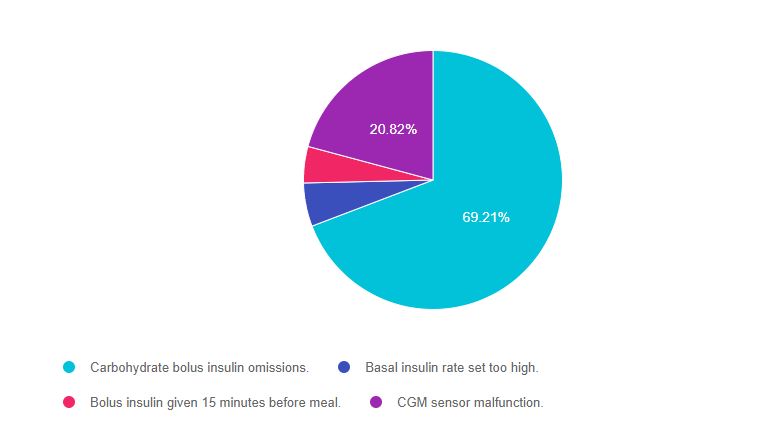
As shown above, the most common choice was option 1, the second most common answer was option 4, then option 2, and finally option 3.
Getting to the Best Answer
If you are thinking about taking the certification exam, the content of this practice test question will set you up for success. The exam will present questions that require test takers to be familiar with diabetes technology and helping people with problem solving and getting glucose to target.
Answers & Rationale
Answer 1 is correct, 69.21% chose this answer, “Carbohydrate bolus insulin omissions.” GREAT JOB! Skipping coverage for carbs, even once a day, can lead to a 1% increase in A1c. When discussing the data download with RT, the diabetes specialist will recognize all the actions that RT is doing correctly. Then, the specialist will share their observations that it seems RT sometimes skips bolusing for carb intake. The specialist can pause and see what RT says or the specialist could say something like, “can you tell me more about what is happening around these meals?”
Answer 2 is incorrect, 5.43% of you chose this answer, “Basal insulin rate set too high.” Getting to the correct basal rate is important to maintain glucose levels on target. If the basal rate is set too high, this means that RT would be getting too much insulin. This would result in hypoglycemia and a drop in A1c.
Answer 3 is incorrect, 4.55% of you chose this answer, “Bolus insulin given 15 minutes before meal.” The timing of bolus insulin before meals can make a big difference in getting glucose to target. Giving bolus insulin 15 minutes before meals can actually improve glucose levels since it allows the insulin peak to more closely match the post meal glucose elevation.
Answer 4 is incorrect, 20.82% of you chose this answer, “CGM sensor malfunction.” This is a juicy answer, but it doesn’t match the intent of the question. If the question said, “according to the CGM download the estimated A1c is 7.0% and the lab A1c is 7.9%” then we might consider this answer. However, we have no indication that the CGM sensor wasn’t working, nor do we have any data from the CGM to consider. That’s why this juicy answer is not the best one.
We hope you appreciate this week’s rationale! Thank you so much for taking the time to answer our Question of the Week and participate in this fun learning activity!
Want to learn more about this question and more?
Enroll in our Level 4 | Insulin Calculation Workshop – From Injections to Pumps Course | 1.5 CEs

Determining basal and bolus rates for multiple daily injections or insulin pumps can seem overwhelming. This 90-minute course provides participants with a step-by-step approach to determine basal rates, bolus ratios and how to problem solve when blood glucose levels aren’t on target. During this 90-minute course, Coach Beverly will provide abundant case studies to give participants hands-on practice and build confidence when calculating insulin doses for a variety of situations.
Objectives:
- Describe using formulas to determine appropriate insulin dosing.
- Discuss strategies to determine and fine-tune basal insulin dose
- Describe how to determine and fine-tune bolus rates including coverage for carbs and hyperglycemia.
- Using a case study approach, utilize calculations to determine the best insulin dosing strategy.
2021 Live Webinar Events
See Full Calendar for upcoming webinars and Virtual Courses.
Can’t join live? No worries, we will record the webinar and post it to the Online University!
Sign up for Diabetes Blog Bytes – we post one daily Blog Byte from Monday to Friday. And of course, Tuesday is our Question of the Week. It’s Informative and FREE! Sign up below!
[yikes-mailchimp form=”1″]Accreditation: Diabetes Education Services is an approved provider by the California Board of Registered Nursing, Provider 12640, and Commission on Dietetic Registration (CDR), Provider DI002. Since these programs are approved by the CDR it satisfies the CE requirements for the CDCES regardless of your profession.*
The use of DES products does not guarantee the successful passage of the CDCES exam. CBDCE does not endorse any preparatory or review materials for the CDCES exam, except for those published by CBDCE.
Rationale of Week | Kidney Transplant and Hyperglycemia – Best Action?

Most of you, 73%, chose the best answer for our April 27th Question of the Week. Great job! We wanted to “take a closer look” into this question.
Before we start though, if you don’t want any spoilers and haven’t tried the question yet, you can answer below: Answer Question
Question: JR is a 38 yr old who received a kidney transplant 3 months ago and has a GFR >60 and creatinine of 0.9. JR takes prednisone 10mg daily as part of the post-transplant protocol. JR’s most recent A1c came back at 7.9% and the provider asks the Diabetes Specialist what intervention is recommended.
Which of the following is the best response?
Answer Choices:
- Refer to a kidney specialist for a thorough workup.
- Encourage referral for medical nutrition therapy.
- Evaluate if JR can cut the prednisone dose in half.
- Instruct JR to start a very low-calorie diet to reverse hyperglycemia.
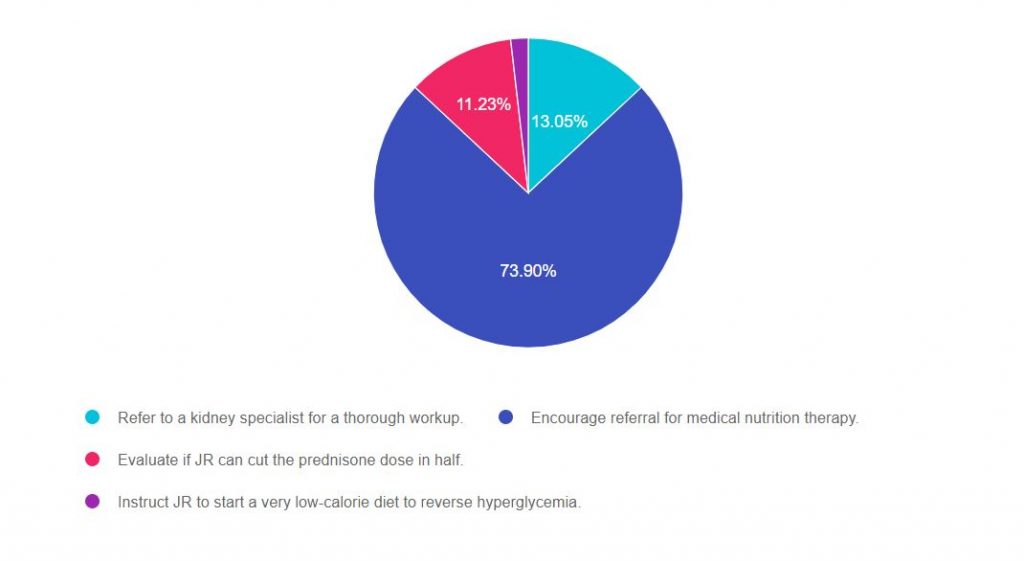
As shown above, the most common choice was option 2, the second most common answer was option 1, then option 3, and finally option 4.
Getting to the Best Answer
If you are thinking about taking the certification exam, the content of this practice test question will set you up for success. The exam will present questions that require test takers to be familiar with identifying common diabetes co-conditions, screening guidelines and interventions.
Answers & Rationale
Answer 1 is incorrect, 13.05% chose this answer, “Refer to a kidney specialist for a thorough workup.” As many as 10-40% of solid organ transplant recipients develop post-transplant diabetes (PTDM). This is due to a combination of genetic susceptibility plus the anti-rejection medications, including steroid therapy (see slide below). Since JRs kidney function is terrific based on his GFR and creatinine, referring to a kidney specialist is not warranted. However, referring to DSME is high on the list of priorities.
Answer 2 is correct, 73.90% of you chose this answer, “Encourage referral for medical nutrition therapy.” YES, this is the BEST answer. For any person experiencing post-transplant diabetes, they will need a referral to an RD/RDN and DSME program to learn diabetes self-management strategies. They will also need medication therapy, but there is currently no standard treatment approach due to the complexities of mixing transplant medications with diabetes therapies. However, insulin therapy is a safe and effective option for those experiencing post-transplant hyperglycemia.
Answer 3 is incorrect, 11.23% of you chose this answer, “Evaluate if JR can cut the prednisone dose in half.” Prednisone therapy is a critical intervention to prevent post-transplant rejection. For this reason, maintaining prednisone therapy is a priority. Diabetes specialists can help determine strategies to keep glucose on target to prevent infection, support graft health and limit other complications.
Answer 4 is incorrect, 1.82% of you chose this answer, “Instruct JR to start a very low-calorie diet to reverse hyperglycemia.” To maintain graft function and quality of life post-transplant, a very low-calorie diet is not recommended. To address this JR’s treatment plan will include a combination of healthy eating, activity plus diabetes medications.
We hope you appreciate this week’s rationale! Thank you so much for taking the time to answer our Question of the Week and participate in this fun learning activity!
Want to learn more about this question and more?
Enroll in our Level 2 – Critical Assessment – Fine-Tuning your Diabetes Detective Skills – 2.0 CEs

Diabetes Education Services Online University Courses are an excellent way to study for your exam anytime and anywhere that is convenient for you. You will have immediate access to your courses for 1 year after your purchase date. Each individual online course includes a: 90-minute video presentation, podcast, practice test, and additional resources.
This course integrates the ADA Standard of Care on elements of a comprehensive medical assessment (Standard 4) of the individual living with prediabetes, diabetes, or hyperglycemia. Through case studies and real-life situations, we discover often hidden causes of hyperglycemia and other complications, such as liver disease, sleep apnea, pancreatitis, autoimmune diseases, fractures, and more. We delve into therapy for complicated situations and discuss management strategies for other conditions associated with hyperglycemia such as Cystic Fibrosis, and Transplants. Join us for this unique and interesting approach to assessing and evaluating the hidden complications of diabetes.
Topics Include:
- Identify common yet often underdiagnosed complications associated with type 1 and type 2 diabetes.
- State strategies to identify previously undiscovered diabetes complications during assessments.
- Discuss links between hyperglycemia and other conditions including, transplant, cystic fibrosis and liver disease.
Intended Audience: A great course for healthcare professionals who want to learn the steps involved in providing a thorough lower extremity assessment.
Instructor: Beverly Thomassian RN, MPH, CDCES, BC-ADM is a working educator and a nationally recognized diabetes expert.
Can’t join live? No worries, we will record the webinar and post it to the Online University!
Sign up for Diabetes Blog Bytes – we post one daily Blog Byte from Monday to Friday. And of course, Tuesday is our Question of the Week. It’s Informative and FREE! Sign up below!
[yikes-mailchimp form=”1″]Accreditation: Diabetes Education Services is an approved provider by the California Board of Registered Nursing, Provider 12640, and Commission on Dietetic Registration (CDR), Provider DI002. Since these programs are approved by the CDR it satisfies the CE requirements for the CDCES regardless of your profession.*
The use of DES products does not guarantee the successful passage of the CDCES exam. CBDCE does not endorse any preparatory or review materials for the CDCES exam, except for those published by CBDCE.








